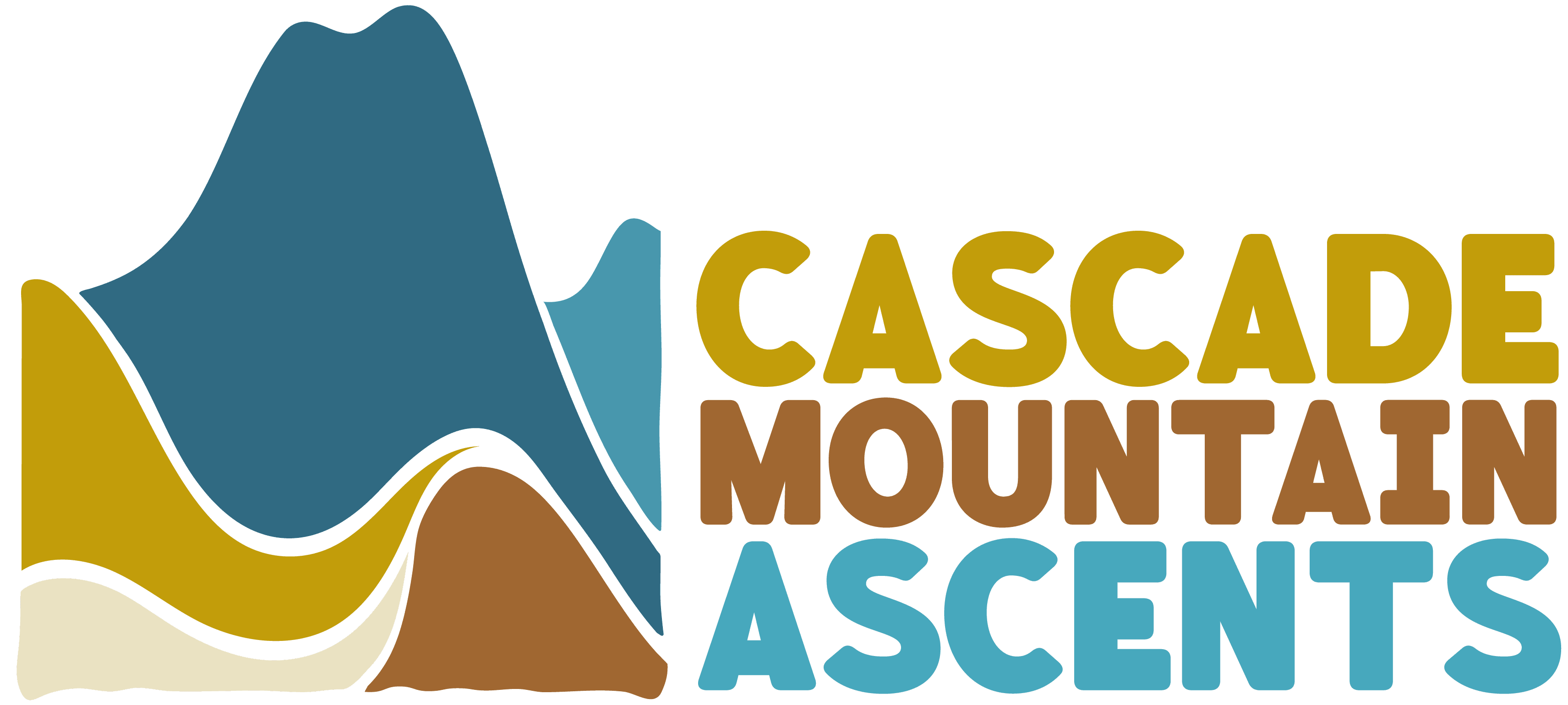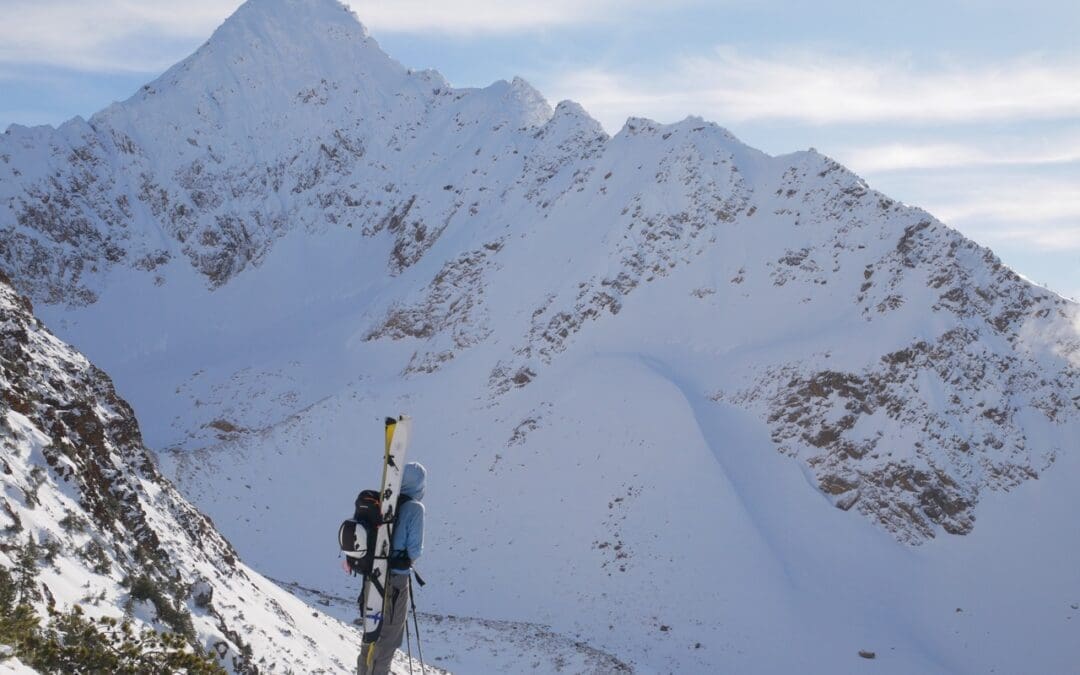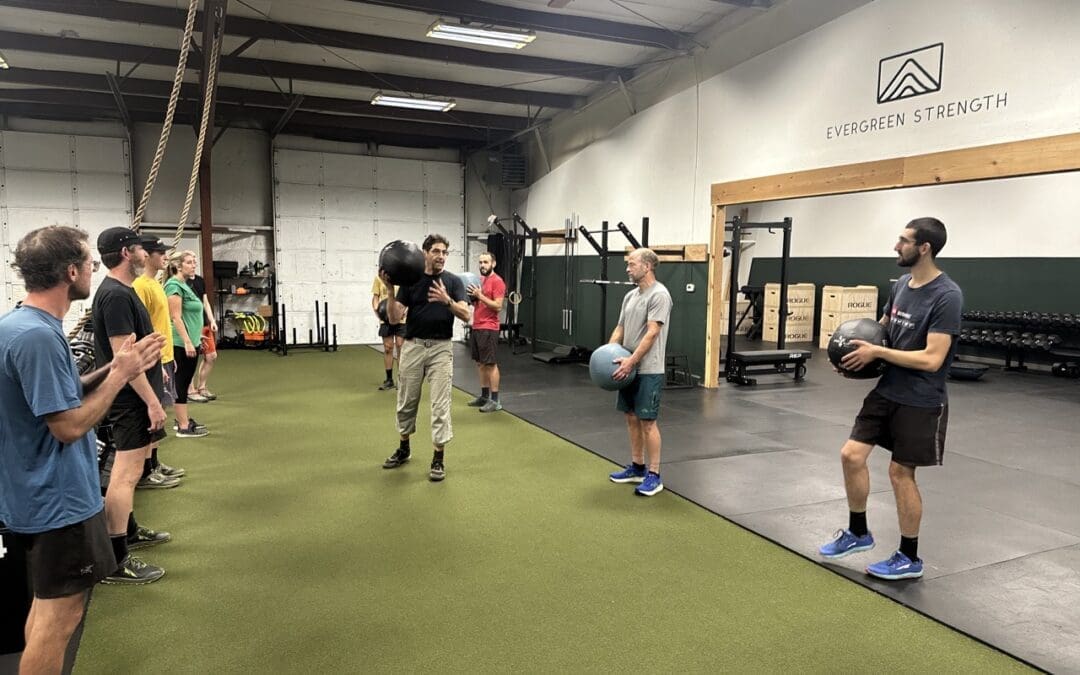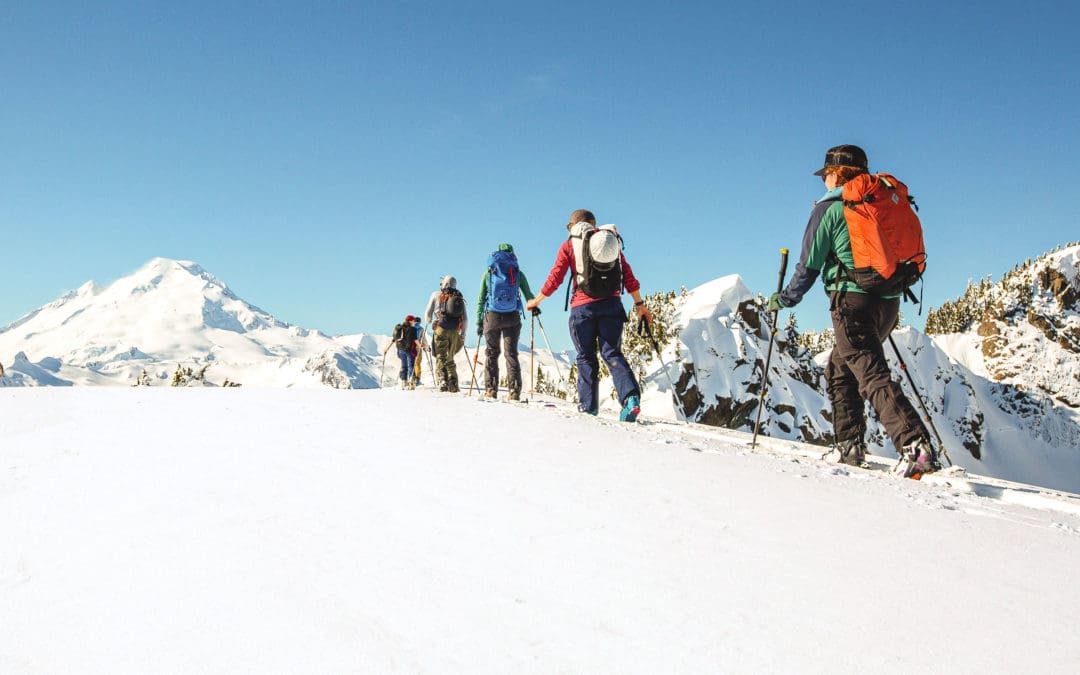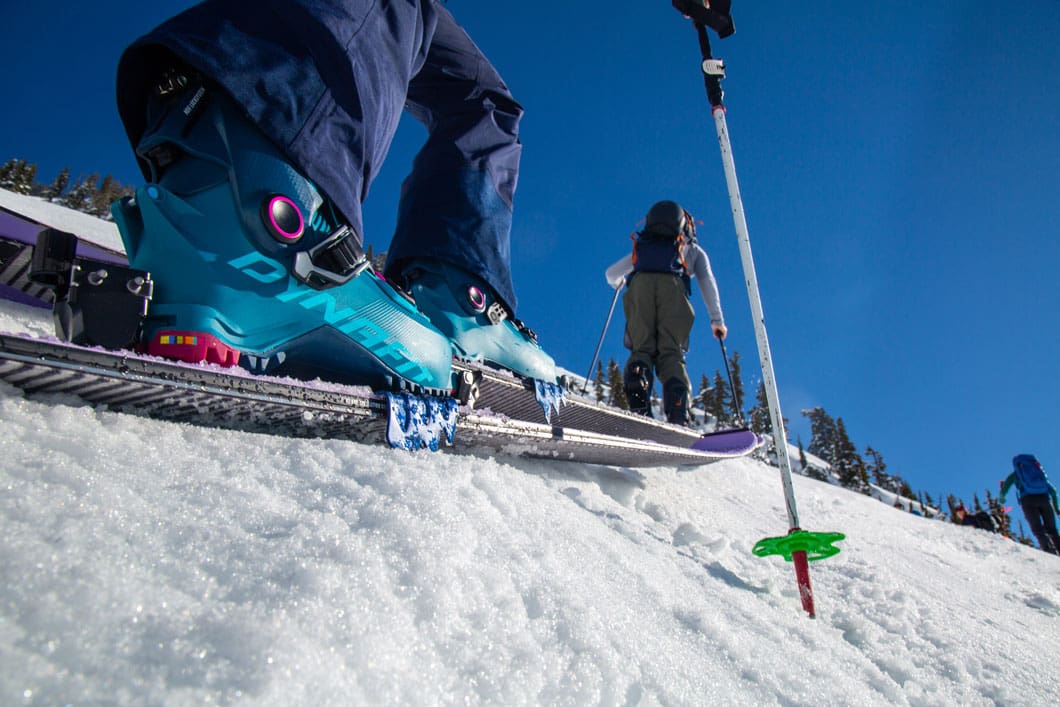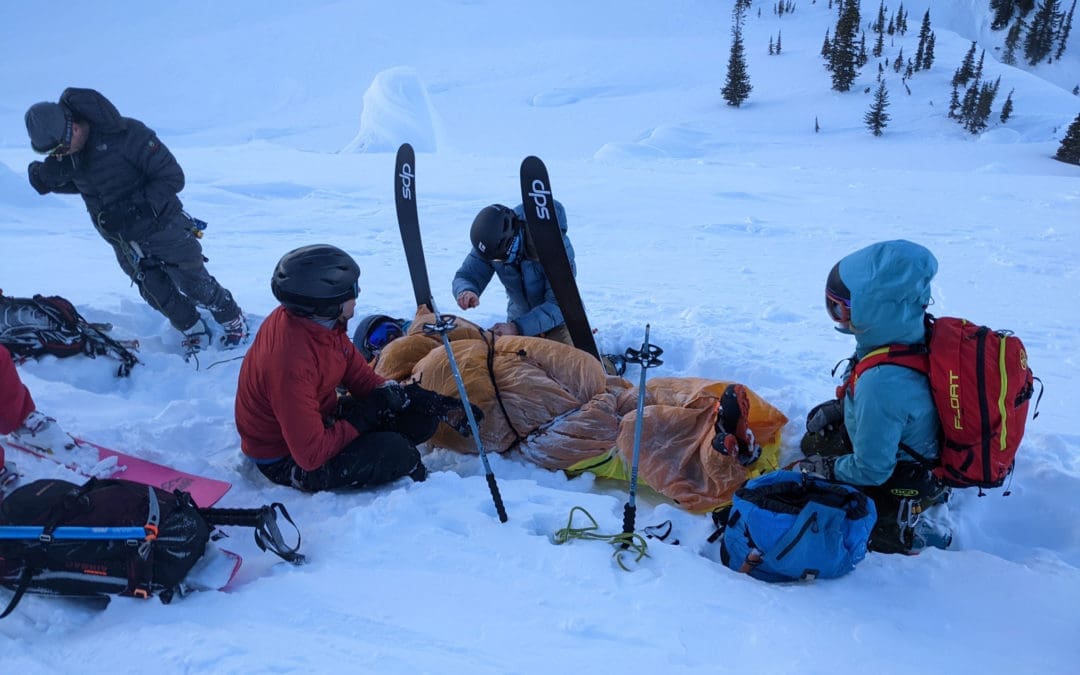Basic Backcountry Navigation
By: Zack McGill
I’m going to sound like an old curmudgeon saying this, but folks these days rely too heavily on technology to navigate in the backcountry. With “easy” access to technology, anyone can now turn their cell phone into a stand-alone GPS unit that puts a blue dot wherever they are in terrain. In lieu of any real basic backcountry navigation knowledge, folks resort to staring at their phones to get them through terrain. If your phone dies, do you have the knowledge to get out of the backcountry?
Also, to truly use your cell phone to navigate you must first understand the basics of navigation. These include:
- Understanding the Compass
- Reading Topographical Maps
- How to use a map and compass together to Take and Follow a Bearing
The Compass
If you’ve ever been in a complete whiteout with rain being driven so hard into you you think it may drive through your soul and out your other side… first off, what are you doing out in that? And secondly… really hope you had a compass! As long as your legs keep working and your hands are able to hold on, the compass will get you where you want to go. Below you’ll find the parts of the compass and what they’re for.
Base Plate
The foundation of your compass is the base plate. Most compasses nowadays have clear plastic for the base plate so you can see the map below. Yes, a real map that you can hold in your hands you digital divas. They still exist. The base plate has at least one straight edge marked with scales, a direction of travel arrow (orange in the diagram below), and index lines.

Housing
The housing is the liquid-filled capsule that contains the magnetic needle at the center of your compass. Why have liquid in there? It helps dampen the needle movement, making it easier to get an accurate reading.
Dial or “Bezel”
The dial (yellow in the diagram above) is the moveable part of the housing. When the dial is rotated, the orienting arrow, declination scale, and orienting lines also rotate as part of the housing. North, South, East, and West are found inscribed on each quarter of the dial, and the 360 degree circumference is broken down at 2 degree intervals.
Magnetic Needle
The magnetic strip of metal that is on a pivot in the center of the housing is the magnetic needle. The part of the needle that points north is usually painted red, while the other side is often white or black. The magnetic needle points towards magnetic north and is kind of the reason a compass works! Watch out for and sort of bubble or damage to your housing, as this can throw off the magnetic needle.
Direction of Travel Arrow
Tells you which direction to point your compass in order to follow a bearing in the field.
Sighting Mirror
Not all compasses come with a sighting mirror, but if you’re a backcountry skier or rider… get one that does! You can utilize sighting mirrors to measure slope angle, which is important when operating in avalanche terrain. See below:
In the video, you can see how the mirror allows you to view the compass dial and the background at the same time. Beyond slope angle, the vertical lines on the mirror can be extended (conceptually) into the horizon to more accurately target your desired bearing.

Orienting Arrow
The orienting arrow is marked (in red) on the bottom of the housing and rotates with the housing. It allows the baseplate to be positioned relative to the magnetic needle, which is important when you want to follow a bearing (more on that soon).
Orienting Lines
These lines are marked on the bottom of the housing and rotate with it, the same as the orienting arrow. They are also often called “meridian lines” and “north-south lines.” When taking a bearing from a physical map, the orienting lines are aligned with the north-south map grid lines.
Topographic Maps
Topographic maps (you often hear “Topo Maps” for short) represent 3-Dimensional terrain in a 2-Dimensional format. Through colors, and symbols, Topo maps are able to convey quite precise information to the map reader. They detail natural features like glaciers, rivers, lakes, and forest as well as man-made features such as roads, railways, power lines, and geographical names. Green in the map below details forest where white is alpine slopes devoid of vegetation.
All that said, it’s important to remember that these maps are accurate to the time they were created! The Earth is constantly changing (sometimes pretty quickly) and some land features that were present at the maps creation, may be no more. Trees also grow and trails no longer get maintained.
Contour Lines
Beyond colors and symbols, the main part of a topo map that allows you to “see” the 3-D landscape are contour lines. Contour lines show elevation and the shape of terrain by connecting points of equal elevation. This means that if you physically walked along a contour line and never deviated from it, you’d stay at the same elevation forever.
Common contour intervals – the elevation change between contour lines- range from 40′(Most the lower 48) to 100′ (Alaska). The wider contour lines are, the flatter the terrain (think a big meadow or field). On the flip side, the closer contour lines are together, the steeper the terrain (cliffs, couloirs). Basically, you take a mountain and squish it flat on a page. The diagram below will help you visualize what that looks like.
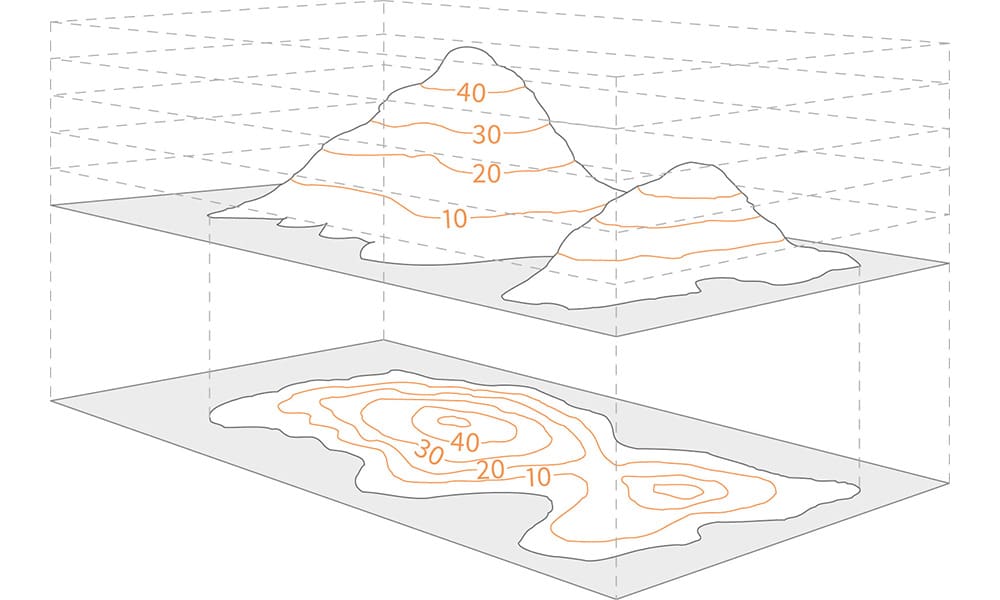
High Points and Low Points
Contour lines connect points of equal elevation. Remember the example above of walking along a contour line? You’d stay at the same elevation forever. You’d also eventually get back to where you started. Contour lines are circular in nature! Because of this, high points and low points are actually circular. Can you find the high points on the summit plateau of Mount Baker (Kulshan) below? How about the low points in the Sherman Crater?

Ridges, Gullies, and Couloirs
Other terrain features besides summits and low points that are good to train the eye to see are ridges, gullies, and couloirs. You often hear of these as the “V’s” and “U’s” in your topo map contour lines. To identify ridges, there is usually low ground in three directions and high ground in one direction. When crossing a ridge at right angles, there is a steep climb to the crest and then a steep descent to the base. When moving along the ridge, depending on the location, there may be either an almost imperceptible slope (pretty flat ridge) or a very visible incline (steeper climbing — think West Ridge of Forbidden.) The closed end of the contour line (Bottom of the V or U) points away from high ground. The ridges in the image below are marked in light yellow. The blue lines mark a saddle or pass, which is a low point along a ridge.
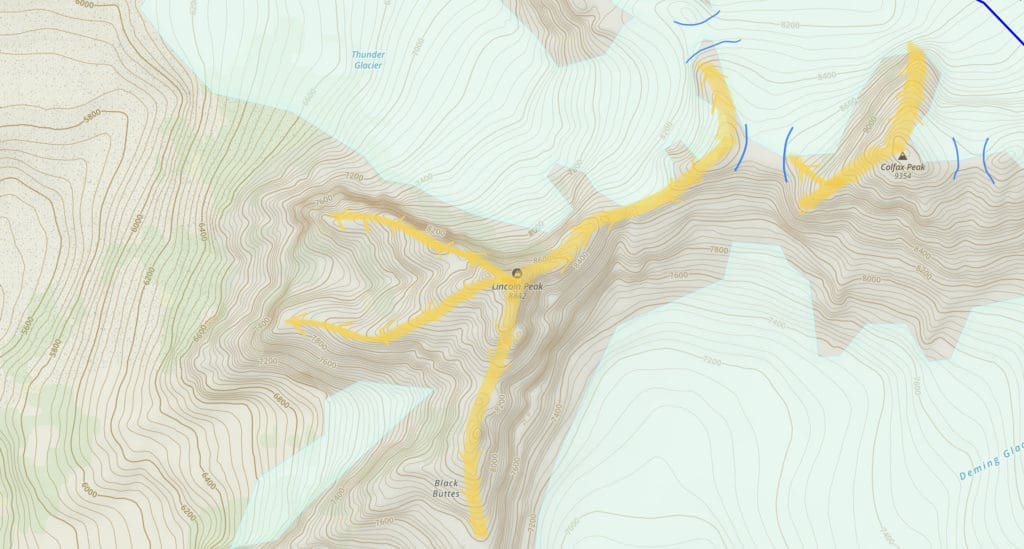
The opposite of a ridge on a topo map is a gully or couloir. For these terrain features, the closed end of the contour line always pointing upstream or toward high ground. Being the opposite, instead of low points on three sides, it has high points on three sides. A valley is just a large, mellow gully if you think about it. In the image below, there are multiple gullies coming off of Granite Mountain and Mt. Sefrit ending in the valley below. Hint: water often flows in gullies and couloirs, depicted by a blue line.
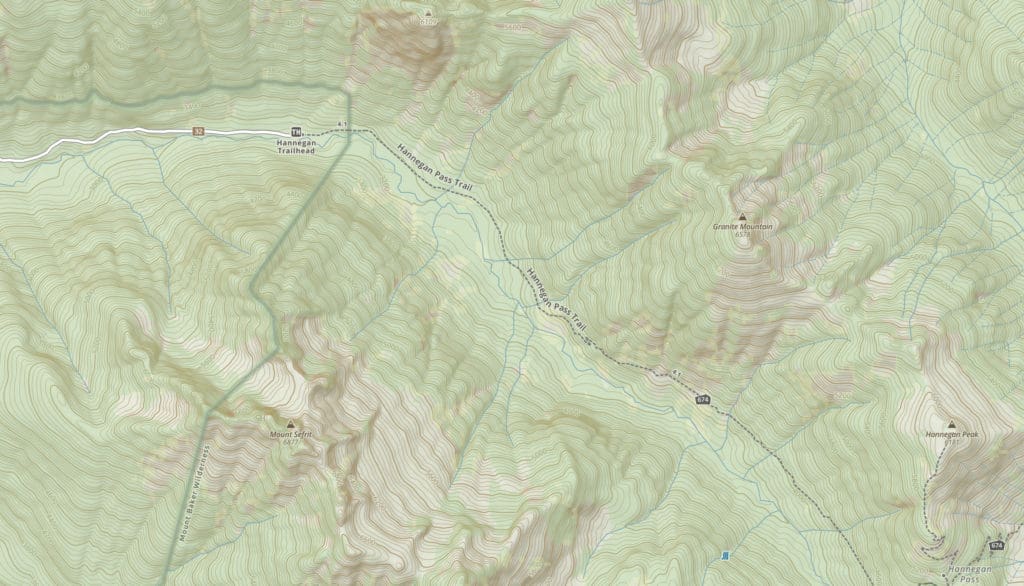
Taking a Bearing
Hopefully you now understand a bit more about the compass and the basics of reading a topographical map. If those are new concepts to you and you’re just trying to skip ahead to the ending… don’t! Go back and read the things. For the rest of y’all, let’s get into how to actually use a compass and map to find your way.
Declination
I’ve mentioned this word a few times… “Declination”… so let’s get into it. It’s good to know about declination because our compass and map don’t work perfectly together unless you adjust for it. Declination is the difference between Magnetic North (what your compass points to) and True North (What maps are oriented to).
You may ask yourself… Zack… why don’t the map makers just use magnetic north to create the maps!? Why even use true north? Well folks, this is because magnetic north, and therefore declination, changes on a yearly basis and depending on where you are geographically. Thankfully, it’s an easy enough fix. You can look up the declination in your area on the NOAA Website and then adjust for it.
Once you know your declination, most compasses allow you to rotate the actual housing in order to have the declination adjusted for. If you’ve got a compass that can do this, check out the video below to learn how and about declination in general.
If not, you’ll have to do the math, but it’s not that bad. That’s coming from someone who doesn’t like math. You will be adding to your bearing (if your declination is east) or subtracting from (if your declination is west). For where I live in WA at the time of writing this, the declination is 15 degrees East. In order for my compass to point to true north (0 degrees), I’ll just need to turn my dial 15 degrees counterclockwise. Again, this is because I would actually be facing 15 degrees (not 0 degrees) if I lined up my compass to face north without adjusting for declination.
Bearings
Once you’ve adjusted for declination, bearings are the way we can navigate through terrain and know we’re on the right track. To take a bearing using a map:
Step 1: first figure out where you are and where you want to go. For this, it’s good to use clear landmarks. In the example below, I’m using the first switchback on the Elbow Lake Trail (Point A) as my location and the bottom of Green Creek Arete (Point B) as where I want to end up.
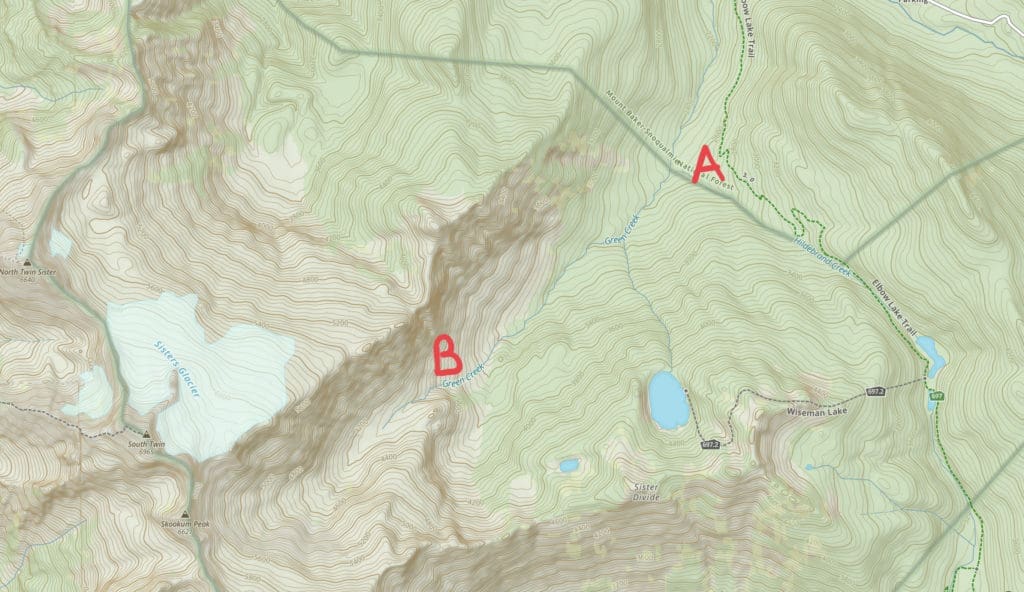
Step 2: Ensure your map is oriented to North. The text should be right side up for reading purposes.
Step 3: Place your compass with the straight edge along the invisible line that would Connect point A and Point B.
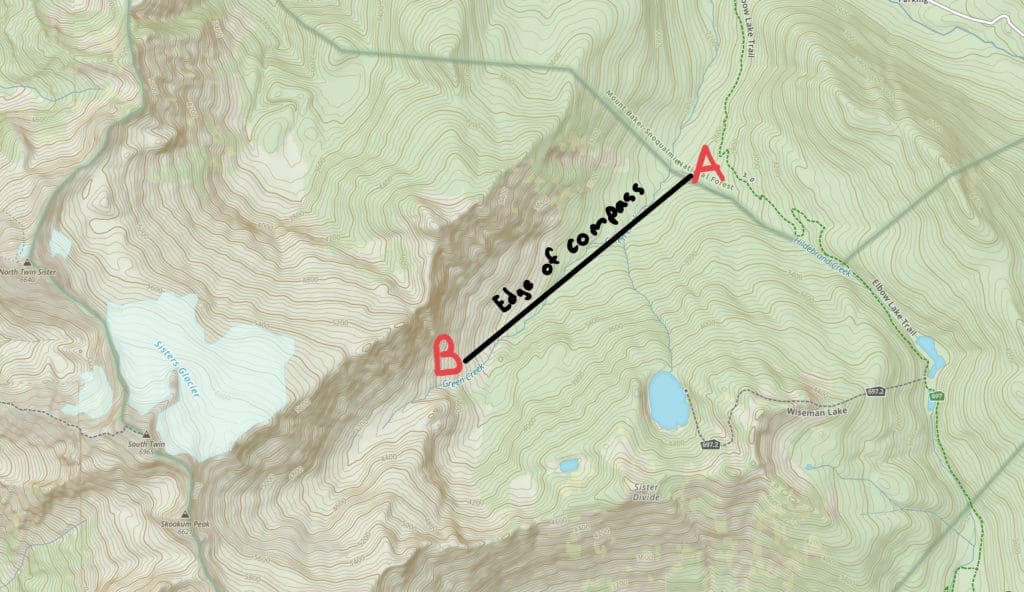
Step 4: Rotate the dial so that the orienting lines are parallel to the lines on the map and the compass housing is pointed north. In the image below, a ruler is overlayed to show the lines on the map being parallel to the orienting lines in your compass housing.
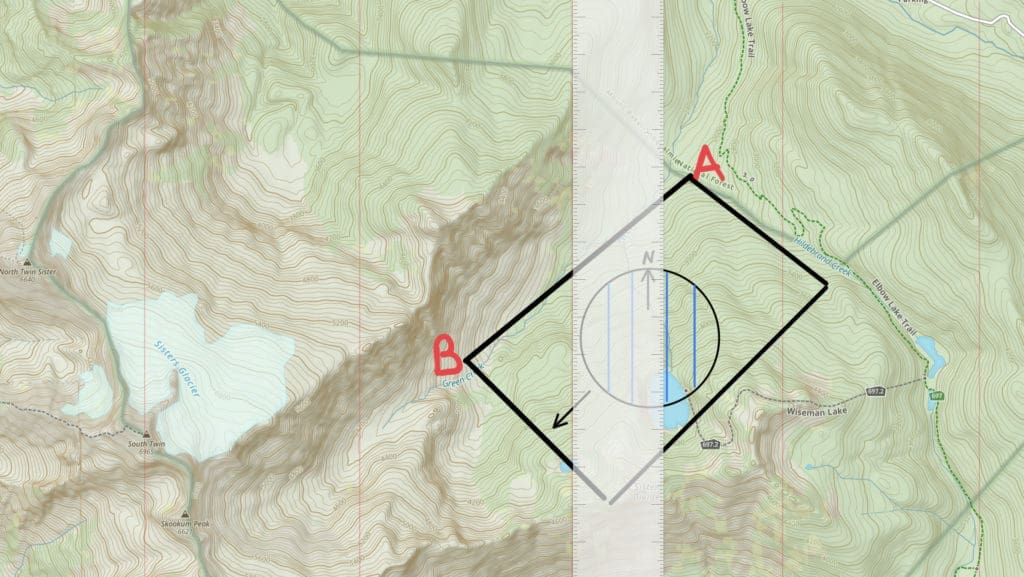
Step 5: Take your compass off the map and whatever number is where your direction of travel arrow is pointing is your bearing. In the image below and this example, that is 230 Degrees South West. To follow it, just turn the compass until the red magnetic needle is inside the orienting arrow. Remember, if you haven’t adjusted for declination yet, you’ll need to do so here.

Below is a short video told in a cute accent to summarize. If you’re not totally burnt out by navigation and are looking for more, check out our resource on Whiteout Navigation to learn how to take bearings and navigation to the next level.
